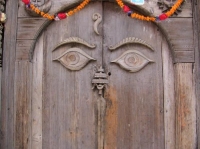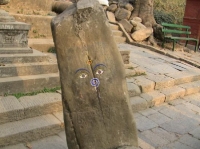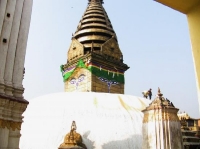According to Ayurveda the eye is created and maintained by the Fire Element. As such, the eye is adversely affected by excess heat, and just as the tears of the eye, as well as the aqueous and viteous humors function to nourish and cool the eye, Ayurvedic recommends supportive measures to balance the Fire Element. This includes hygienic measures such as washing the face three to four times a day, taking regular baths, a healthy diet, living and working in areas with adequate ventilation or outside in the fresh air, and the ancient practice of peering at the cooling rays of the moon.
General Eye Medicines
 Among the most important general eye remedies is Triphala churna, prepared as an eyewash by soaking equal parts freshly dried Amalaki fruit (Phyllanthus emblica), Bibhitaki fruit (Terminalia belerica) and Haritaki fruit (Terminalia chebula) in room temperature water overnight. In the morning the water is carefully filtered and used as an eyewash. If only the powder is used to make the infusion, filtering must be done with fine clean linen to filter out any particulate. This eyewash is good for general eye health, and can be also used for conjunctivitis.
Among the most important general eye remedies is Triphala churna, prepared as an eyewash by soaking equal parts freshly dried Amalaki fruit (Phyllanthus emblica), Bibhitaki fruit (Terminalia belerica) and Haritaki fruit (Terminalia chebula) in room temperature water overnight. In the morning the water is carefully filtered and used as an eyewash. If only the powder is used to make the infusion, filtering must be done with fine clean linen to filter out any particulate. This eyewash is good for general eye health, and can be also used for conjunctivitis.
Another common eye remedy is Rasanjana eyedrops, made by dissolving the condensed paste extract of either Daruharidra (barberry / Berberis nepalensis) or Darvi root (Berberis asiatica) in water, used to wash the eyes every fifth day or once a week. These eyedrops reduce inflammation (Pitta) and mucus (Kapha), clean the eyes and help keep the duct system open.
To maintain the natural power of vision and prevent cataract formation, a collyrium (external application) made of the purified microfine powder called Sauvira Bhasma (purified antimony sulfide) can be painted across the entire bottom eyelid each night, making a line about 1/2 inch in width directly under the lash.
Degenerative eye diseases such as macular degeneration can be treated with eye restoratives based upon Triphala (Phyllanthus emblica / Terminalia belerica / Terminalia chebula) and other general Rasayanas. For chronic eye inflammation such as iritis and uveitis, Triphala can be used along with the general anti-Pitta medicines, mild laxative remedies, and anti-inflammatory medicines.
Abhisyanda (Conjunctivitis)
 Abhisyanda is correlated with conjunctivitis, caused by inflammation of the conjunctiva. It is classified into four categories, with the characters of Vata, Pitta, Kapha and Raktaja. General remedies include either Triphala eyewash or Rasanjana eyedrops. Bilwanjana eye salve is another general remedy used for conjunctivitis as well as glaucoma. It relieves pain and subdues swelling. It is made from filtered juice of Bilwa leaf (Aegle marmelos) mixed with Saindhavam (mineral salt) and ghrita (clarified butter / ghee). This is ground with ghee colored Kauda Bhasma (cowries), cooked and mixed with gou kshira (cow milk). In severe cases, laxative remedies and venesection can be prescribed as well.
Abhisyanda is correlated with conjunctivitis, caused by inflammation of the conjunctiva. It is classified into four categories, with the characters of Vata, Pitta, Kapha and Raktaja. General remedies include either Triphala eyewash or Rasanjana eyedrops. Bilwanjana eye salve is another general remedy used for conjunctivitis as well as glaucoma. It relieves pain and subdues swelling. It is made from filtered juice of Bilwa leaf (Aegle marmelos) mixed with Saindhavam (mineral salt) and ghrita (clarified butter / ghee). This is ground with ghee colored Kauda Bhasma (cowries), cooked and mixed with gou kshira (cow milk). In severe cases, laxative remedies and venesection can be prescribed as well.
Vataja Conjunctivitis
Conjunctivitis with the character of Vata causes painful eyes, headache, dryness and cold tears. It is treated with the general Vata treatments along with specific remedies and laxative remedies. Netrabindu eyedrop is a specific medicine against Vataja conjunctivitis, prepared by mixing one part of Sphutikarika (purified alum) to 100 parts of water distilled with a tiny amount of Karapura leaf (camphor / Cinnamomum camphora).
Pittaja conjunctivitis
Conjunctivitis with the character of Pitta causes infection, hot sensation and hot tears. It is treated with the general Pitta treatments along with laxative remedies and Rasanjana eyedrops, or Samudraphenam (sea foam / Sepia species) mixed with shtri kshira (breast milk).
Kaphaja conjunctivitis
Conjunctivitis with the character of Kapha causes itching, edema and a sticky discharge. It is treated with the general Kapha treatments along with laxative remedies and Netrabindu eyedrops (page 3) prepared with Rasanjana (condensed paste of Berberis nepalensis or Berberis asiatica).
Raktaja conjunctivitis
Conjunctivitis with the character of Raktaja causes red eyes, hot sensation and infection. It is treated with the general Pitta treatments along with purgative remedies. Netrabindu eyedrops (page 3) are used, after adding Rasanjana or Mallayoga {Sankhavisha Bhasma (purified white arsenic) with Swarnapatri leaf (senna / Cassia auriculata) and Amalaki fruit (Phyllanthus emblica).
Adhimantha (Glaucoma)
 Adhimantha is correlated with glaucoma, and is caused by a severe painful pressure inside the eyes. It is classified into four categories, with the character of Vata, Pitta, Kapha and Raktaja. All forms of glaucoma can lead to blindness if not treated properly. Without such treatment, the ancient texts state that the patient with Vataja glaucoma can be blind after six days, after five days in Raktaja glaucoma, and after seven days Kaphaja glaucoma. With Pittaja glaucoma blindness can occur at any time.
Adhimantha is correlated with glaucoma, and is caused by a severe painful pressure inside the eyes. It is classified into four categories, with the character of Vata, Pitta, Kapha and Raktaja. All forms of glaucoma can lead to blindness if not treated properly. Without such treatment, the ancient texts state that the patient with Vataja glaucoma can be blind after six days, after five days in Raktaja glaucoma, and after seven days Kaphaja glaucoma. With Pittaja glaucoma blindness can occur at any time.
Long-term measures to preserve vision utilize a combination of general treatments and specific treatments based on the indicated doshas. Useful herbs in all cases include Punarnava plant/root (Boerhavia difusa), Shatavari root (asparagus / Asparagus racemosus), Triphala (Phyllanthus emblica / Terminalia belerica / Terminalia chebula), Triphaladi ghritam and Sirasularivajrarasa vati. Externally, Bilwanjana eye salve can also be used, as well as Netrabindu eyedrops (page 3).
Vataja glaucoma
Glaucoma with the character of Vata causes severe migraine-like headaches, dryness, cold tears and severe pain in the eyes. Without proper treatment, a patient at this stage can be blind after one week, and thus treatment should begin immediately after diagnosis. The first step is to prescribe aged ghrita (ghee which is at least 10 years old) to drink. Then, after applying a warm compress, the excess blood is drained from the eye by venesection. Following this, the eyes are treated with a preparation made from goat’s milk mixed with water and cooked with Hriverum plant (Pavonia odorata), Tagara bark (Erytania coronarea), Manjistha plant (Indian madder / Rubia cordifolia) and Udumbara bark (Ficus glomerata). General measures to reduce Vata are used along with laxative remedies and enema. A medicated oil made from Shalaparni plant (Desmodium gangeticum), milk, and a sweet plant such as Madhukam root (licorice / Glycyrrhiza glabra) is prescribed to use in the form of snuff.
Pittaja Glaucoma
Glaucoma with the character of Pitta manifests with a severe migraine-like headache, hot sensation, infection, hot tears and burning painful eyes. Blindness can quickly follow. Venesection operation, cleaning the bowels with laxative remedies, eyewash with a cooling decoction, application of anti-inflammatory plasters around the eyes, and the use of snuff and collyriums are all very important to apply as soon as possible. Other general anti-Pitta methods can be used. After the crisis is over, a condensed paste made from the decoction of Trivrit root (Indian rhubarb /Operculina turpenthum) or Madhukam root (licorice / Glycyrrhiza glabra), and mixed with sugar and honey is effective to use in the form of an anjana, painted over the eyelids.
Kaphaja glaucoma
Glaucoma with the character of Kapha causes a severe migraine-like headache, itching, edema, and a sticky discharge. It is treated with general measures to reduce Kapha along with venesection, laxative remedies and specific remedies for external and internal uses, including a medicated hot compress and eyedrops. Three days of fasting can be helpful, and an anti-Kapha diet, using drying foods that reduce mucus, is very important.
For the hot compress, a paste is used made from Syonaka root/bark (Indian trumpet flower / Oroxylon indicum), Aparajita root (butterfly pea / Clitoria ternatea), Tulsi plant (holy basil / Ocimum sanctum), Bilwa fruit (bael / Aegle marmelos), Rakta Chandanam wood (red sandalwood / Pterocarpus santalinus), Pilu nut (wild walnut), Arka (milkweed / Calotropis gigantea), Kapittha fruit (wood apple / Feronia limonia) and Bijaya leaf (hemp / Cannabis sativa).
The eyedrops are made from Haritaki fruit (Terminalia chebula), Haridra root (turmeric / Curcuma longa), Madhukam root (licorice / Glycyrrhiza glabra) and Sauvira Bhasma (purified antimony sulfide).
Raktaja glaucoma
Glaucoma with the character of Raktaja is caused by severe migraine like headache, painful eyes, hot sensation and infection. It is treated with the general Pitta treatments along with venesection, laxative remedies and specific remedies for external and internal use. Also important is to cleanse the nasal passageways. In this case, a ghee preparation made of laxative remedies with sugar is used as a snuff that causes discharge by sneezing. To relieve the severe pain do the following a light fomentation is used, followed by leeches applied around the eyes to suck out the blood. This is then followed by administering large doses of ghrita (ghee) internally, along with the treatments mentioned under Pittaja glaucoma.
Additional headings in this chapter*
Hatadhimantha (Acute Glaucoma / Phthisis Bulbi)
Netrapaka (Degenerative Ophthalmitis)
Vataparyaya (Ophthalmodynia / Tic Douleroux)
Shuskakshipaka (Dry Blepharitis / Xerophthalmia)
Anyatovata (Ophthalmoneuritis / Optic Neuritis)
Amladhyusita (Ophthalmia)
Sirotpata (Ophthalmorrhagia)
Sirapraharsa (Chronic Varicula / Neglected Hyphema)
Shuklam (Corneal Ulcer)
Akshipakatyaya (Corneal Pannus)
Ajakajatam (Interstitial Keratitis)
Pittavidagdhadristi (Photophobia)
Kaphavidagdhadristi (Night Blindness)
Dhumadarshi (Unclear Vision / Amblyopia)
Hraswajadya (Photophobia)
Nakulandhya (Defective Vision With Colorful Illumination)
Gambhirika (Contraction Of The Lens / Hypermature Or Calcific Lens)
Linganasha (Cataract)
Timira (Errors Of Refraction / Eyecoat Illnesses)
Lens Defects (Sthiladosha)
Arma (Pterygium)
Shuktika (Episcleral Blue Spots / Nevus Of Ota / Axenfeld’s Loops)
Arjunam (Episcleral Red Spot)
Pistakam (Episcleral White Spot)
Sirajala (Varicula / Telangiectasia)
Sirajapidaka (Angioma Of The Conjunctiva)
Balasakakhya (Concretion / Bitot’s Spot)
Puyalasa (Dacryocystitis)
Upanaaha
Netrasaava (Eye Diseases With Epiphora)
Parvani (Dacryolith)
Alaji (Dacryoma Located Toward The Iris / Scleral Nodule / Scleritis)
Krimigranthi (Parasitic Blepharitis)
Utsangapidaka (Chalazion, Small)
Kumbhika (Melanoma On Eyelid)
Pothaki (Trachoma / Viral Follicular Conjunctivitis)
Vartamasharkara (Squamous Blepharitis / Staphylococcal Blepharitis)
Arshovartma (Blepharoncus)
Shuskarsha (Dry Blepharoncus)
Anjananamika (Sty / Hordeolum)
Bahalavartma (Xanthelasma / Blepharopachynsis)
Vartmabandhaka (Blepharitis, Complex / Eyelid Swelling)
Klistavartma (Allergic Blepharitis)
Vartmakardama (Ulcerous Blepharitis / Blepharoconjunctivitis, Exudative)
Shyavavartma
Praklinnavartma / Klinnavartma / Pilla (Allergic Edema)
Aklinnvartma (Ankyloblepharon / Symblepharon)
Vatahatavartma (Blepharoplegia)
Netrarbuda (Cancer Of The Eyelid)
Nimesam (Blepharospasm / Myokymia)
Shonitarsha (Angioma Of The Eyelid / Melanoma Of The Eyelid)
Lagana (Chalazion, Large)
Visavartma (Ulcerative Edema Of The Eyelid)
Kunchanam (Blepharoptosis / Ptosis)
Pakshmakopa (Trichiasis)
Pakshmashata (Eyelid Alopecia)
To acquire the complete contents of “Ayurveda In Nepal: The Bajracharya Samhita” please click here.
0 Responses to “Diseases of the Eyes”